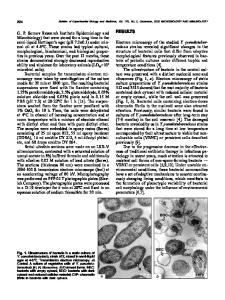Sand failure: effect of biocide on the geomechanical properties of outcrop carbonate rock under static condition
- PDF / 1,482,957 Bytes
- 7 Pages / 595.276 x 790.866 pts Page_size
- 20 Downloads / 275 Views
1ST CAJG 2018
Sand failure: effect of biocide on the geomechanical properties of outcrop carbonate rock under static condition Elizabeth Wuyep 1
&
Gbenga Oluyemi 1 & Kyari Yates 2 & Alfred R. Akisanya 3
Received: 14 July 2019 / Accepted: 26 October 2020 # The Author(s) 2020
Abstract The effects of chemical interaction of a biocide with formation rocks on the rock geomechanical properties are examined. A combination of analytical tests (scanning electron microscopy/energy-dispersive X-ray analysis, X-ray powder diffraction and particle size distribution) and uniaxial compression test was used in this study. The particle size distribution in the effluent showed an increase in D50 with poor sorting for the chemically treated outcrop carbonate core samples. The XRPD shows evidence of altered minerals in the chemically treated samples. It was observed that the interaction led to precipitation of new materials that clogged the pore space of the samples leading to up to 150% increase in compressive strength of the carbonate following treatment with the biocide. The results give more insight into the limitations of existing sand production prediction models with respect to the effect of oilfield chemicals on the strength of the reservoir rocks. Keywords Chemical interaction . Glutaraldehyde . Dolomite . Uniaxial compressive strength . Reservoir rock
Introduction Biocides are typically used in oil and gas industry to control the activities of undesirable bacteria and microorganisms that produce some substances, such as H2S and organic acids, which can cause corrosion of production tubulars, casings and facilities. Unfortunately, the deleterious effect of the interaction of the biocide with the reservoir rock has not always been accounted for nor widely studied. The interaction of chemicals with the reservoir rocks under static condition has not been widely published. Seto et al. (1997) examined the effect of polyethylene oxide (PEO), aluminium chloride (AlCl3) and This paper was selected from the 1st Conference of the Arabian Journal of Geosciences (CAJG), Tunisia 2018 Responsible Editor: Amjad Kallel
dodecyltrimethylammonium bromide (DTAB) on sandstone under static condition to establish fundamental knowledge for chemically assisted fracturing. It was found that these chemicals did not cause any significant change in the compressive strength of the sandstone. The chemistry and composition of the chemicals used in the work are different from those of biocide and other commonly used oilfield chemicals. Wuyep et al. (2018) investigated the effect of a scale inhibitor (amino trimethylene phosphonic acid) ATMP, a biocide (glutaraldehyde) and a corrosion inhibitor (betaine) on the strength of reservoir rocks under static condition to quantify the effects of these chemicals on sand failure. This current work further explores the deleterious effect of a biocide on the geomechanical strength of outcrop carbonate rock with a view to drawing comparison if any, between the effects of the chemical on carbonate reservoir rocks an
Data Loading...











